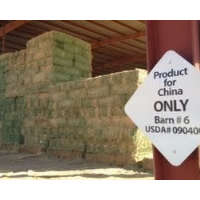Could California Drought be Ended by Stopping Alfalfa Exports to China?
 (photo: XM MLB Chat)
(photo: XM MLB Chat)
Many parts of the Golden State are looking more yellow these days as California’s fields dry up amid the worst drought on record. The lack of rain and snowfall has caused state reservoirs to reach critically low levels, leaving farmers in the agriculturally important Central Valley desperate for irrigation water.
But not all California farmers are thirsting for H2O.
Those tilling the ground in the Imperial Valley, located in the southeastern tip of the state near Mexico, have all the water they need to grow crops.
One commodity in particular, though, has become a source of debate: alfalfa.
Imperial farmers are growing vast amounts of the hay for export to China and other countries. In doing so, the state is indirectly exporting billions of gallons of water overseas, due to alfalfa’s water-hungry biology.
Professor Robert Glennon, who teaches a course on water law at the James E. Rogers College of Law at the University of Arizona, estimates California is shipping “a hundred billion gallons of water per year” in the form of alfalfa.
“It’s a huge amount. It’s enough for a year’s supply for a million families — it’s a lot of water, particularly when you’re looking at the dreadful drought throughout the South-west,” Glennon told BBC News.
California finds itself in this bizarre situation because it is actually cheaper to transport bales of hay to the Port of Long Beach and ship it to China than it is to truck the same crop from the Imperial Valley to the Central Valley.
That may partially explain why U.S. alfalfa exports from ports in the West have skyrocketed in recent years, from 2,321 metric tons in 2007 to 177,423 metric tons in 2011.
Meanwhile, Central Valley farmers are watching their fields turn to dust, while cattlemen sell off herds because they can’t afford to feed them.
The California water crisis has no easy answer.
Even if Imperial farmers stopped using the water they get from the Colorado River to grow alfalfa for export, they couldn’t just turn around and sell the water to their counterparts up north to alleviate the impact of the drought.
First, there’s the complicated legal matter of water rights bestowed to Imperial farmers, which can’t be transferred willy-nilly.
Second, despite the billions of dollars that California invested in canals during the 20th century to move water from one part of the state to another, there is no conveyance linking the Imperial and Central Valleys that would allow water to flow from south to north.
Imperial growers get their water from the All-American Canal that moves Colorado River water originating out of state, while farmers in the Central Valley have always relied on water from two other canals: the State Water Project (SWP) and the Central Valley Project (CVP), both of which pull from sources in Northern California.
Central Valley farmers got two rounds of bad news last month, when both the CVP and SWP announced separately that water allocations to farmers would drop to zero due to the prolonged drought.
-Noel Brinkerhoff
To Learn More:
California Drought: Why Farmers are 'Exporting Water' to China (by Alastair Leithead, BBC News)
Parched in the West but Shipping Water to China, Bale by Bale (by Peter Culp and Robert Glennon, Wall Street Journal)
Most Central Valley Growers to Get No Water from Central Valley Project (by Bettina Boxall, Los Angeles Times)
State Water Project Allocation Cut to Zero (Central Valley Business Times)
Boehner, GOP Propose Solution to California Water Problems: Gut Environmental Protection (by Ken Broder, AllGov California)
- Top Stories
- Unusual News
- Where is the Money Going?
- Controversies
- U.S. and the World
- Appointments and Resignations
- Latest News
- Trump to Stop Deportations If…
- Trump Denounces World Series
- What If China Invaded the United States?
- Donald Trump Has a Mental Health Problem and It Has a Name
- Trump Goes on Renaming Frenzy






Comments